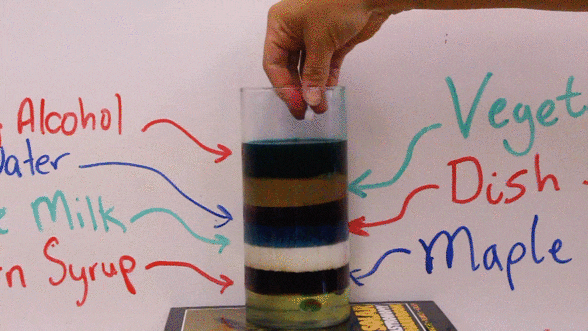
Heat rises, boats float, clouds hang listlessly in the sky, and icebergs aimlessly bob around the ocean. All of these things happen because of the same scientific property: density!
Understanding Density
Density is a rather simple property. It depends on two things, mass and volume. Mass is basically how much something weighs, but something still has the same amount of mass weather it is on Earth, Jupiter, or out in space where its weight would change dramatically. Volume doesn’t have anything to do with how loud something is, but rather with how much space it takes up. Mathematically, an object’s density is equal to its mass divided by its volume.
Examples of Density In Space
By simply comparing the density of different things, we can tell if they would float or sink in water or air or anything else that has a known density. This is incredibly useful and can lead to some fun facts. For example, Saturn is less dense than water. That is to say it would float in a bathtub, but it might leave some rings! Red giant stars, like the famous Betelgeuse, are actually less dense than air! They are incredibly heavy–Betelgeuse weighs in at about 18 suns worth of mass–but they take up so much space that they are essentially GIANT balloons! The sun would not float like a balloon now, in fact it is currently much more dense than water. However, given 5 billion years it will enter the red giant phase of its own life and grow in volume by about 800 million times! This will decrease its density so much that it goes from 40% higher than water to lower than air! As you can clearly see, density is not necessarily a constant property of something, it is actually something that can change.
One of the most commonly accepted consequences of density is that heat rises, but that isn’t technically true. It would be more correct to say that heat rises on Earth. This is because as things warm up, their volume increases which lowers their density. However, if we leave the friendly confines of Earth, this is no longer true! In the microgravity environment aboard the International Space Station, there isn’t really an “up” or “down”, gravitationally speaking. That makes it hard to decide what “heat rises” even means! Fire gets equally confused. Check out this comparison between fire on Earth and aboard the ISS from NASA.
DIY Density Experiments
Create a Density Column
Why do these liquids stack so cleanly? For the same reason that helium floats on air, and air floats on water: it’s all about density. Denser substances are heavier by volume, so they sink beneath less dense substances. We can layer household substances of different densities to get a crazy stack of liquids!
The seven ingredients that we are using are honey, corn syrup, maple syrup, whole milk, dish soap, water, and vegetable oil. Just to spice things up we added a bit of food coloring to the water. If you pour them in order of most dense to less dense, they do a really good job in staying separated. However, the food coloring that was added to the water turned out to be more dense than water and the dish soap and started mixing in with the milk layer!
Ideally, if we mixed up the density column and incorporated all of the ingredients together, after a few hours we would be able to get the layers back. However, the dish soap will react to the milk and oil, making separation impossible for every single layer.

The corn syrup is the most dense of our layers because there’s more “stuff” squeezed into a cubic inch of corn syrup than a cubic inch of maple syrup, whole milk, or any of the other density column ingredients. Weigh a fluid ounce of each liquid and you’ll find that corn syrup is the heaviest. It makes sense that it should sit at the bottom of the stack!

Diet Coke vs Coke: Which One Floats?
Another experiment you can try at home only requires 3 things: two cans, one of Coke and one of Diet Coke, and water. These clearly have the same volume, but do they have the same density? It’s pretty hard to tell in air, so let’s take it to water. Drop them both in at the same time and watch what happens! The can of Coke will sink to the bottom, while the can of Diet Coke will float. So what’s the difference? A can of coke has about 39 grams of sugar which is about 10 teaspoons full. Where as a can of Diet Coke doesn’t have any. Instead, Diet Coke has an artificial sweetener in it called aspartame, that has the same amount of sweetness in it as regular Coke, but only uses as much as a few drops of it. So regular Coke will sink because it quite literally has more stuff in it.
So, things don’t float or sink due to how much they weigh, but rather it’s due to how much matter they have packed into a certain space.


